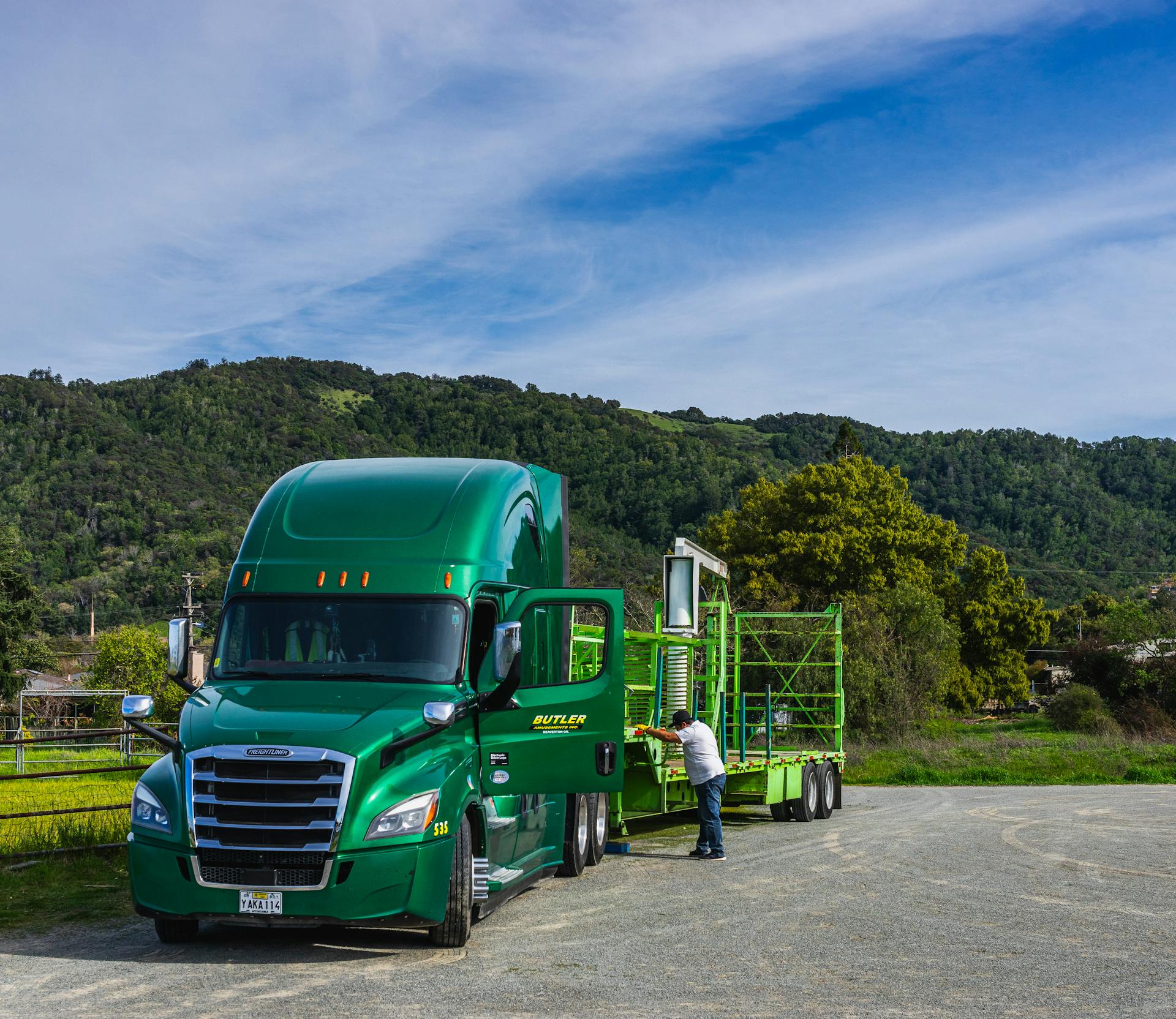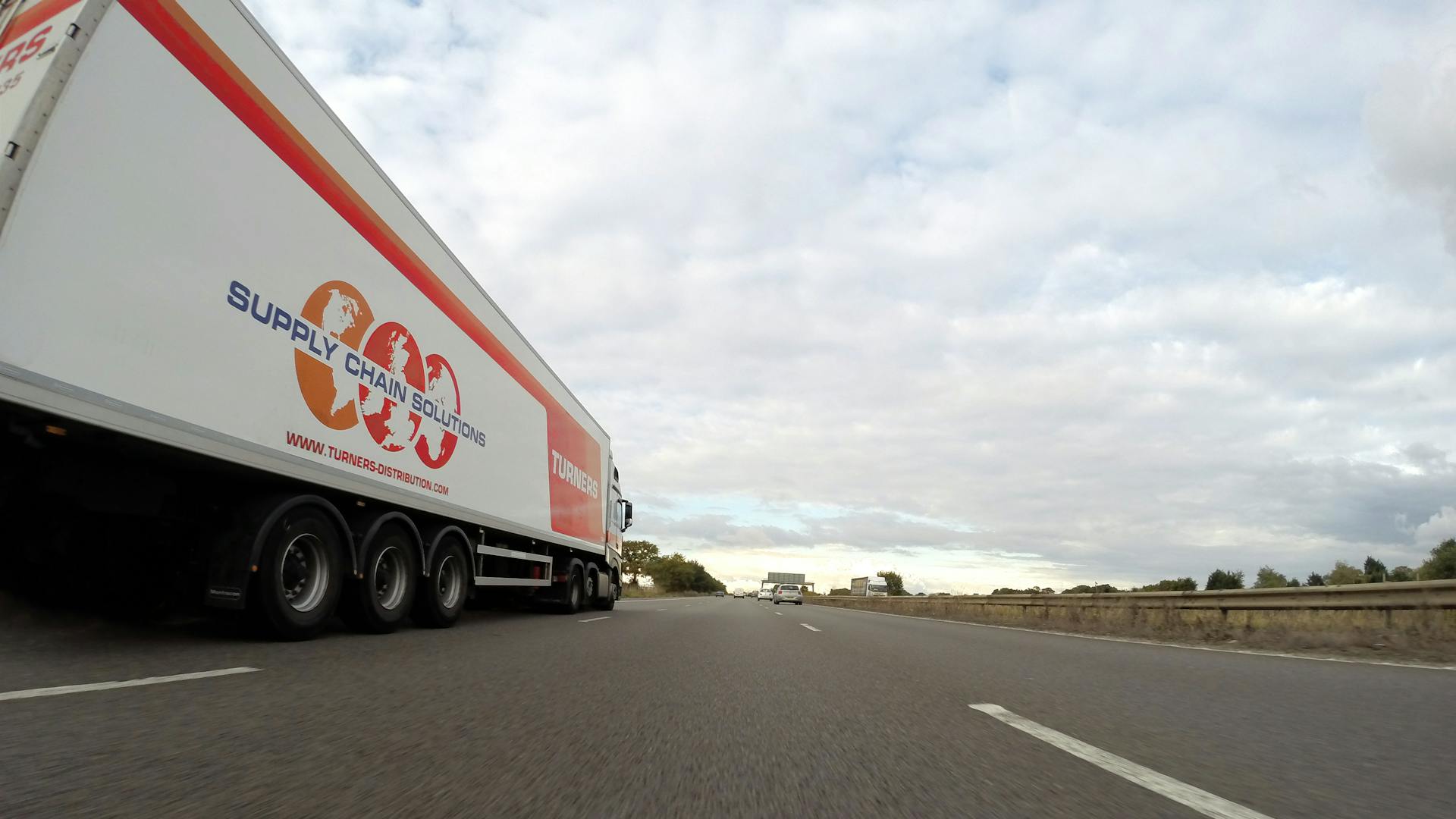
The trailer tail on semi trucks is a simple yet effective way to reduce drag and fuel consumption. A study found that a trailer tail can increase a truck's fuel efficiency by up to 4.5%.
By reducing drag, a trailer tail can also help to decrease the wear and tear on a truck's engine. This can lead to longer engine life and reduced maintenance costs.
The shape and design of a trailer tail can make a big difference in its effectiveness. A curved trailer tail can deflect air more efficiently than a flat one, reducing drag by up to 10%.
Trailer Tails
Trailer Tails are aerodynamic add-ons designed to reduce fuel consumption by reducing drag. They're typically added to the back of a truck at an angle to help with airflow.
These panels are foldable, allowing trucks to be loaded and unloaded easily. They were first patented in the 1930s for use with railcars and have since been redesigned and streamlined.
The gap between the tractor and the trailer can account for about 25% of drag, creating a vortex that causes friction. This can reduce fuel savings.
Trailer Tails can make a big difference in fuel consumption, with some companies like Midwest Carriers being repeatedly named an EPA SmartWay High Performer for reducing carbon emissions.
Aerodynamics on Semi-Trucks
Aerodynamics on Semi-Trucks plays a crucial role in reducing fuel consumption. The four major areas that affect aerodynamic drag on a semi-truck are the front of the tractor, the gap between the trailer and the tractor, the sides and underbody of the trailer, and the back of the trailer.
These areas are naturally where methods are used to make semi-trucks more aerodynamic. The aerodynamic drag of a semi-truck can be significantly reduced by addressing these four areas.
Here are the four major areas that affect aerodynamic drag on a semi-truck:
- Front of the tractor
- Gap between the trailer and the tractor
- Sides and underbody of the trailer
- Back of the trailer
Benefits of Trailer Tails
Trailer tails are a crucial component of semi-truck aerodynamics, and they offer several benefits. They can reduce drag by up to 4.5% when properly designed and installed.
A well-designed trailer tail can reduce the aerodynamic drag on a semi-truck by creating a smooth flow of air around the trailer. This can lead to significant fuel savings, especially on long hauls.
According to our article, the drag reduction achieved by a trailer tail can be attributed to its ability to eliminate the vortex that forms behind the trailer, also known as the "vortex shedding." This vortex can cause significant drag and reduce fuel efficiency.
In addition to reducing drag, trailer tails can also help to reduce wind resistance and improve overall aerodynamics. This can lead to improved fuel efficiency and reduced emissions.
By installing a trailer tail, truck drivers can expect to see a noticeable improvement in their vehicle's aerodynamics and a corresponding reduction in fuel consumption.
Reducing Drag
Reducing drag on semi-trucks is crucial for fuel efficiency. The aerodynamic drag of a semi-truck is affected by four major areas.
The front of the tractor, the gap between the trailer and the tractor, the sides and underbody of the trailer, and the back of the trailer all contribute to drag.

A key area to focus on is the gap between the tractor and the trailer, which accounts for about 25% of drag. This gap creates a vortex, causing friction.
To minimize drag, it's essential to address these four areas. One way to do this is by using devices like TrailerTails, which are added to the back of the truck at an angle to reduce drag.
Here are the four areas that affect the aerodynamic drag of a semi-truck:
- The front of the tractor
- The gap between the trailer and the tractor
- The sides and underbody of the trailer
- The back of the trailer
By understanding and addressing these areas, you can make significant improvements to your semi-truck's aerodynamics and reduce fuel consumption.
Minimized Trailer Gap
A well-designed trailer tail can greatly benefit from a minimized gap between the trailer and the tractor. This is because the gap creates a vortex, which causes friction and accounts for about 25% of drag in a semi-truck's aerodynamics.
A smaller gap means less friction, which can lead to significant fuel savings. In fact, the fuel savings are directly related to the size of the gap, with larger gaps resulting in reduced savings due to increased friction.
By minimizing the trailer gap, you can help your semi-truck run more efficiently and reduce its environmental impact.
Causes of Trailer Gap
The trailer gap can be a real problem on the road. One of the main causes is uneven wear on the trailer's tires, which can lead to a gap of up to 3 inches.
Incorrect tire inflation is a common mistake that can cause trailer gap. Underinflated tires can lead to a sagging trailer, while overinflated tires can cause it to ride too high.
Poor trailer suspension can also contribute to trailer gap. A worn-out or damaged suspension system can cause the trailer to sag or bounce, creating a gap.
The weight distribution of the trailer's cargo can also affect the trailer gap. If the cargo is not properly secured or is unevenly distributed, it can cause the trailer to tilt or sag.
A mismatched or worn-out hitch can also cause trailer gap. A hitch that's not properly aligned or is worn out can cause the trailer to pull away from the tow vehicle, creating a gap.
Solutions for Minimizing Trailer Gap
The gap between the tractor and the trailer is a major contributor to drag, accounting for about 25% of it. This is because the gap creates a vortex that causes friction.
To minimize this gap, we can look at the design of the TrailerTail, which is added to the back of a truck at an angle to reduce drag.
The TrailerTail was first patented in the 1930s for use with railcars and has been redesigned and streamlined over time. This shows that even small adjustments can make a big difference in aerodynamics.
By minimizing the gap between the tractor and the trailer, we can reduce friction and save fuel.
Sources
- https://petroleumservicecompany.com/blog/the-science-behind-trailer-tails-and-skirts/
- https://www.truckingtruth.com/truckers-forum/Topic-17077/Page-1/do-trailer-tails-really-work
- https://drivemidwest.com/2020/06/12/what-are-those-things-on-the-back-of-your-trailer/
- https://trucklabs.com/blog/trailer-aerodynamics/
- https://nextexitlogistics.com/semi-truck-aerodynamics-works/
Featured Images: pexels.com


